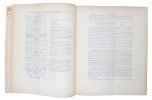"CURIE, (MARIE) SKLODOWSKA. - THE DISCOVERY OF THE RADIOACTIVITY OF THORIUM - COINING THE TERM 'RADIOACTIVITY'
Rayons émis par les composés de l'uranium et de thorium. Presentée par M. Lippmann. Séance du Mardi 12 Avril 1898).
Paris, Gauthier-Villars, 1898. 4to. No wrappers. In: ""Comptes Rendus Hebdomadaires des Séances de L'Academie des Sciences"", Tome 126, No 15). Entire issue offered. With htitle and titlepage to vol. 126. Pp. 1059-1110. Curie's paper: pp. 1101-1103.
Reference : 46852
First printing of this milestone paper, being the first ""Note"" from Marie Curie about ""radioactivity"". This same ""Note"" contains a the fundamental observation: ""Two uranium ores... are much more active than uranium itself. This fact... leads one to believe that these ores may contain an element much more active than uranium."" This paper gives the first proof of the fact that radiation is an atomic property.""Henri Becquerel, discovered (1896) that uranium salts shielded from light for several months spontaneously emit rays related in their effects to Roentgen rays. Mme. Curie became enthusiastic about this subject filled with the unknown and, as she later acknowledged, involving no bibliographic research.The first step in the research was to determine whether there existed other elements capable, like uranium, of emitting radiation. Abandoning the idea of hyperfluorescence, couldn’t one calculate by electrical measurement the effects on the conductivity of air that were revealed by the gold-leaf electroscope? Pierre Curie and his brother Jacques had constructed an extremely sensitive apparatus to measure weak currents"" Mme. Curie employed it in testing both pure substances and various ores. In her first ""Note"" in the Comptes rendus""de l Académie des sciences (12 April 1898) she described the method that she followed throughout her life, the method that enabled her to make comparisons through time and crosschecks with other techniques:""I employed... a plate condenser, one of the plates being covered with a uniform layer of uranium or of another finely pulverized substance [(diameter of the plates, eight centimeters"" distance between them, three centimeters). A potential difference of 100 volts was established between the plates.]. The current that traversed the condenser was measured in absolute value by means of an electrometer and a piezoelectric quartz. In general she preferred the zero method, in which the operator compensates for the current created by the active material by manipulating the quartz. All of her students followed this procedure.""(DSB).The first results came in 1898: the measurements varied between 83 × 10-12 amperes for pitch blende to less than 0.3 × 10-12 for almost inactive salts, passing through 53 × 10-12 for thorium oxide and for chalcolite (double phosphate of uranium and copper). Thorium would thus be ""radioactive"" (the term is Mme. Curie’s" its radioactive properties were discovered at the same time, independently, by Schmidt in Germany.
Bookseller's contact details
Herman H. J. Lynge & Son
William Schneider
Silkegade 11
1113 Copenhagen
Denmark
+45 33 155 335
Payment mode
Sale conditions
All items may be returned for a full refund for any reason within 14 days of receipt.
1 book(s) with the same title
"CURIE, (MARIE) SKLODOWSKA. - RADIATION IS AN ATOMIC PROPERTY - COINING THE TERM 'RADIOACTIVITY'
Reference : 49598
(1898)
Rayons émis par les composés de l'uranium et de thorium. Presentée par M. Lippmann. Séance du Mardi 12 Avril 1898).
Paris, Gauthier-Villars, 1898. 4to. No wrappers. In: ""Comptes Rendus Hebdomadaires des Séances de L'Academie des Sciences"", Tome 126, No 15). Entire issue offered. With htitle and titlepage to vol. 126. Pp. 1059-1110. Curie's paper: pp. 1101-1103. Clean and fine. A punched stamp in lower margin of title-page.
First printing of this milestone paper, being the first ""Note"" from Marie Curie about ""radioactivity"". This same ""Note"" contains a the fundamental observation: ""Two uranium ores... are much more active than uranium itself. This fact... leads one to believe that these ores may contain an element much more active than uranium."" This paper gives the first proof of the fact that radiation is an atomic property.""Henri Becquerel, discovered (1896) that uranium salts shielded from light for several months spontaneously emit rays related in their effects to Roentgen rays. Mme. Curie became enthusiastic about this subject filled with the unknown and, as she later acknowledged, involving no bibliographic research.The first step in the research was to determine whether there existed other elements capable, like uranium, of emitting radiation. Abandoning the idea of hyperfluorescence, couldn’t one calculate by electrical measurement the effects on the conductivity of air that were revealed by the gold-leaf electroscope? Pierre Curie and his brother Jacques had constructed an extremely sensitive apparatus to measure weak currents"" Mme. Curie employed it in testing both pure substances and various ores. In her first ""Note"" in the Comptes rendus""de l Académie des sciences (12 April 1898) she described the method that she followed throughout her life, the method that enabled her to make comparisons through time and crosschecks with other techniques:""I employed... a plate condenser, one of the plates being covered with a uniform layer of uranium or of another finely pulverized substance [(diameter of the plates, eight centimeters"" distance between them, three centimeters). A potential difference of 100 volts was established between the plates.]. The current that traversed the condenser was measured in absolute value by means of an electrometer and a piezoelectric quartz. In general she preferred the zero method, in which the operator compensates for the current created by the active material by manipulating the quartz. All of her students followed this procedure.""(DSB).The first results came in 1898: the measurements varied between 83 × 10-12 amperes for pitch blende to less than 0.3 × 10-12 for almost inactive salts, passing through 53 × 10-12 for thorium oxide and for chalcolite (double phosphate of uranium and copper). Thorium would thus be ""radioactive"" (the term is Mme. Curie’s" its radioactive properties were discovered at the same time, independently, by Schmidt in Germany.
 Write to the booksellers
Write to the booksellers



